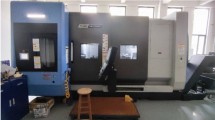Abstract
In the non-servo motor type automatic tool changer (ATC), the rotational transmission mechanism (RTM), which converts the rotary motion with specific rotational ratio, is important. This paper presents a new design for RTM with dual four-bar linkages for the non-servo motor type ATC. This RTM is entirely different from the mechanism using single four-bar linkage, in which the motion is intermittent. In the case of the mechanism using single four-bar linkage, the shape of the trajectory of four-bar linkage is the only design consideration. However, in the case of the proposed mechanism, both the shape and the speed ratio of the contact and non-contact paths of the trajectory of the four-bar linkage have to be considered. Therefore, the four-bar linkages are designed using the new path synthesis algorithm based on the derivative of the target trajectory. Through various analyses, this paper provides the proper design of the RTM. A prototype of a machining center using the developed ATC with RTM was created to verify the feasibility and for kinematic experiments. The research shows that the new RTM with linkage mechanism is suitable for practical applications.













Similar content being viewed by others
References
Fujimoto A, Sato N (2007) Automatic tool changer. US Patent 7300393
Dijksman EA (1966) Jerk-free Geneva wheel driving. J Mech 1(3–4):235–280
Lee J-J, Jan B-H (2009) Design of Geneva mechanisms with curved slots for non-undercutting manufacturing. Mech Mach Theory 44:1192–1200
Figliolini G, Angeles J (2002) Synthesis of conjugate Geneva mechanisms with curved slots. Mech Mach Theory 37:1043–1061
Galkin NB (1934) Intermittent angle transmission. US Patent 1985406
Martin A (1944) Geneva drive. US Patent 2345139
Petroff RJ (1969) Intermittent mechanism and method of making the same. US Patent 3456529
Maue HW, Krupp EJ (1997) Multi-functional apparatus employing an electromagnetic device and an intermittent motion mechanism. US Patent 5694812
Musser C (1960) Breakthrough in mechanical drive design: the harmonic drive. Mach Des 160–172
Freiherr VTH (1941) Planetary gear. US Patent 2231784
Qiu X, Han Q, Chu F (2015) Load-sharing characteristics of planetary gear transmission in horizontal axis wind turbines. Mech Mach Theory 92:391–406
Tuttle TD, Seering WP (1996) A nonlinear model of a harmonic drive gear transmission. IEEE Trans Robot Autom 12(3):368–374
Zou C, Tao T, Jiang G, Mei X, Wu J (2017) A harmonic drive model considering geometry and internal interaction. Proc Inst Mech Eng Part C: J Mech Eng Sci 231(4):728–743
Hui M, Mengjiao F, Zhanwei L, Rangiao F, Bangchun W (2017) Time-varying mesh characteristics of a spur gear pair considering the tip-fillet and friction. Meccanica 52(7):1695–1709
Iglesias M, del Rincon AF, de-Juan A, Diez-Ibarbia A, Garcia P, Viadero F (2015) Advanced model for the calculation of meshing forces in spur gear planetary transmission. Meccanica 50(7):1869–1894
Kwon HS, Kahraman A, Lee HK, Suh HS (2014) An automated design search for single and double-planet planetary gear sets. J Mech Des 136(6):061004
Maiti R (2004) A novel harmonic drive with pure involute tooth gear pair. J Mech Des 126(1):178–182
Tseng C-Y, Yu C-H (2015) Advanced shifting control of synchronizer mechanisms for clutchless automatic manual transmission in an electric vehicle. Mech Mach Theory 84:37–56
Erdman AG, Sandor GN (1997) Mechanism design: analysis and synthesis. Prentice-Hall, New Jersey
Kim JW, Seo T, Kim J (2016) A new design methodology for four-bar linkage mechanisms based on derivations of coupler curve. Mech Mach Theory 100:138–154
Sheih WB, Tasi LW, Azarm S (1997) Design and optimization of a one-degree-of-freedom six-bar leg mechanism for a walking machine. J Field Robot 14(12):871–880
Funabashi H, Ogawa K, Gotoh Y, Kojima F (1985) Synthesis of leg-mechanisms of biped walking machine: part I, synthesis of ankle-path-generator. Bull JSME 28(237):537–543
Martini A, Troncossi M, Carricato M, Rivola A (2014) Elastodynamic behavior of balanced closed-loop mechanisms: numerical analysis of a four-bar linkage. Meccanica 49(3):601–614
Martini A, Troncossi M, Rivola A (2013) Elastodynamic effects of mass-balancing: experimental investigation of a four-bar linkage. Adv Mech Eng 2013:1–11
Raghu E, Balasubramonian A (1990) Experimental study on the elastodynamic behavior of the unbalanced and the counterweighted four bar mechanisms. ASME J Mech Des 112(3):271–277
Acknowledgements
This work was supported by the Technology development Program (C03285300100436557) funded by the Ministry of SMEs and Startups (MSS, Korea).
Author information
Authors and Affiliations
Corresponding author
Ethics declarations
Conflict of interest
The author declare that there is no conflict of interest.
Electronic supplementary material
Below is the link to the electronic supplementary material.
Supplementary material 1 (wmv 39482 KB)
Rights and permissions
About this article
Cite this article
Kim, JW., Lee, S., Seo, T. et al. A new non-servo motor type automatic tool changing mechanism based on rotational transmission with dual four-bar linkages. Meccanica 53, 2447–2459 (2018). https://doi.org/10.1007/s11012-017-0813-z
Received:
Accepted:
Published:
Issue Date:
DOI: https://doi.org/10.1007/s11012-017-0813-z




